Contract Management Software: Essential Guide for 2025
In today’s fast-paced business environment, contracts are the foundation of nearly every interaction. They form the backbone of agreements with clients, vendors, and employees, outlining rights, responsibilities, and expectations. Yet, managing these contracts effectively can be a complex challenge. This blog post will delve into contract management, exploring strategies to streamline processes, mitigate risks, and ensure your agreements work to your advantage.
What is Contract Management Software?
Contract management software is the digital backbone for overseeing the entire life cycle of agreements. Imagine it as a command center for your contracts, centralizing everything from creation and negotiation to signing, storage, and eventual renewal or termination. This software streamlines the often complex process by offering a suite of features designed to make contract management efficient and secure.
Benefits of Contract Management Software
A robust contract management solution can deliver numerous benefits, providing organizations with a streamlined approach to managing their contracts. Here’s a detailed look at the key advantages:
Increased Efficiency and Productivity
- Automated Processes: Contract management software automates repetitive tasks such as contract creation, approval workflows, and renewal notifications, reducing manual effort and saving time.
- Centralized Repository: The software eliminates manual searching by centralizing all contract documents and data in one secure location, enabling staff to find information quickly and easily.
- Task Automation: Automated reminders and alerts ensure that key contract milestones, such as renewal dates and performance reviews, are noticed, improving task management and efficiency.
Improved Visibility and Control
- Real-Time Tracking: Contract management software provides real-time visibility into the status and progress of contracts throughout their lifecycle, enabling stakeholders to track performance, deadlines, and obligations.
- Comprehensive Reporting: Robust reporting and analytics tools allow organizations to gain insights into contract performance, vendor relationships, and potential risks, empowering informed decision-making.
- Audit Trails: The software maintains detailed audit trails of contract activities, including revisions, approvals, and compliance checks, ensuring transparency and accountability.
Reduced Risks and Compliance Violations
- Standardized Processes: Contract management software enforces standardized processes and templates, reducing the risk of errors, inconsistencies, and oversights in contract creation and execution.
- Compliance Monitoring: Automated compliance checks and reminders help organizations stay on top of regulatory requirements, contractual obligations, and internal policies, minimizing the risk of compliance violations and penalties.
- Risk Identification: The software identifies and highlights potential risks and deviations from contract terms, enabling the implementation of proactive risk mitigation strategies.
Enhanced Collaboration and Accessibility
- Centralized Collaboration: Contract management software facilitates collaboration among stakeholders, allowing them to securely access and edit contracts, share documents, and communicate in real-time, regardless of location.
- Role-Based Access: Role-based access controls ensure that only authorized users can access sensitive contract information, protecting confidentiality and preventing unauthorized changes.
- Mobile Accessibility: Many contract management solutions offer mobile applications, enabling users to access contracts and perform tasks on the go, further enhancing collaboration and productivity.
Optimized Contract Performance and Revenue Generation
- Performance Tracking: Contract management software tracks key performance indicators (KPIs) and contract metrics, enabling organizations to monitor contract performance, identify opportunities for improvement, and maximize value.
- Renewal Optimization: Automated renewal notifications and data-driven insights help organizations optimize contract renewals, renegotiate terms, and identify opportunities for upselling or cross-selling, driving revenue growth.
- Vendor Management: The software streamlines vendor management processes, enabling organizations to evaluate vendor performance, negotiate favorable terms, and build stronger supplier relationships, leading to cost savings and improved outcomes.
Improved Data Security and Auditability
- Secure Storage: Contract management software’s safe storage and encryption features shield Sensitive data from cyber threats, illegal access, and data breaches.
- Version Control: Version control features ensure that only the latest, approved versions of contracts are accessed and used, preventing confusion and errors caused by outdated or unauthorized versions.
- Comprehensive Auditing: Detailed audit trails and logs track all contract-related activities, providing a complete historical record of changes, approvals, and access permissions for compliance audits, legal disputes, and internal reviews.
Key Features of Contract Management Software
Effective contract management software typically includes the following key features:
Centralized Repository:
- Provides a centralized database for storing all contracts.
- Ensures easy accessibility and searchability of contracts.
Contract Creation and Templates:
- Offers customizable templates for contract drafting.
- Streamlines the contract creation process.
Version Control:
- Tracks and manages different versions of contracts.
- Ensures that users always have access to the latest version.
Automated Workflows:
- Automates approval processes, notifications, and task assignments.
- Improves efficiency and reduces manual errors.
Contract Tracking and Monitoring:
- Tracks key milestones, deadlines, and obligations.
- Sets up automated alerts and reminders.
Document Management:
- Stores and organizes supporting documents related to contracts.
- Facilitates collaboration and sharing among stakeholders.
Reporting and Analytics:
- Generates reports and dashboards to visualize contract metrics.
- Provides insights for data-driven decision-making.
Integration Capabilities:
- Integrates with other business systems such as CRM and ERP.
- Enables seamless data exchange and synchronization.
Security and Compliance:
- Implements role-based access controls and encryption.
- Maintains audit trails for transparency and compliance.
Integration with Other Systems
- CRM Integration: Streamlining contract creation, maintenance, and tracking within current workflows by integrating with Customer Relationship maintenance (CRM) systems.
- ERP Integration: Linking contract data to finance and procurement procedures through integration with Enterprise Resource Planning (ERP) systems.
- Document Management Integration: Seamless integration with document management systems for storing, organizing, and accessing contract documents and related files.
Choosing the Right Contract Management Software
When evaluating contract management software options, consider the following criteria to ensure you select the solution that best meets your organization’s needs:
Scalability and Flexibility
- Scalability: Ensure the software can scale with your organization’s growth, accommodating an increasing number of contracts and users without performance degradation.
- Flexibility: Select a solution that allows you to customize fields, templates, and workflows to meet your specific contract administration needs.
User-Friendliness and Intuitive Interface
- Ease of Use: Choose software with an intuitive interface and user-friendly design to facilitate quick adoption by users across your organization.
- Accessibility: The program should be accessible on mobile devices and web browsers so that users may handle contracts from anywhere at any time.
Integration Capabilities
- Compatibility: To guarantee smooth data exchange and process automation, evaluate the software’s integration capabilities with current systems, such as CRM, ERP, and document management platforms.
- API Support: Look for software that offers robust API support for easy integration with custom applications and third-party tools.
Industry-Specific Functionality
- Tailored Features: Consider whether the software offers industry-specific functionality or templates to address your industry’s unique requirements and compliance standards.
- Regulatory Compliance: Ensure the software supports compliance with industry regulations, such as GDPR, HIPAA, or SOX, to mitigate risks and ensure data security.
Security and Compliance Features
- Data Encryption: Verify that the software employs robust encryption protocols to protect sensitive contract data in transit and at rest.
- Access Controls: Look for features guaranteeing data integrity and regulatory compliance, such as audit trails and role-based access controls.
- Compliance Monitoring: Choose a solution that offers automated compliance checks and reminders to help you comply with contractual obligations and regulatory requirements.
Vendor Reputation and Support
- Vendor Experience: To assess a vendor’s dependability and dedication to client happiness, look at their background, performance history, and client endorsements.
- Support Services: Consider the technical support available from the vendor, as well as response times and training materials, to make sure you get help when needed.
- Upgrade Path: Consider the vendor’s roadmap for product development and updates to ensure the software remains up-to-date with evolving technology and industry trends.
Implementation and Integration of Contract Management Software
Successful implementation and integration of contract management software require careful planning and consideration of the following factors:
Data Migration and Contract Repository Setup
- Data Assessment: Conduct a thorough assessment of existing contract data to identify relevant information for migration, including contracts, documents, metadata, and associated records.
- Repository Structure: Design a structured repository layout that logically organizes contracts and related documents, ensuring easy retrieval and management.
Process Mapping and Workflow Configuration
- Current Process Analysis: Analyze existing contract management processes to identify pain points, bottlenecks, and areas for improvement.
- Workflow Design: Design and configure automated workflows that reflect your organization’s contract approval, review, and renewal processes, ensuring efficiency and compliance.
User Training and Change Management
- Training Needs Assessment: Identify training needs and requirements for different user groups, including contract managers, approvers, and end-users.
- Training Program Development: Develop comprehensive training materials, including user guides, tutorials, and hands-on workshops, to ensure users are proficient in using the software.
- Change Management: Implement change management techniques to address opposition, encourage user adoption, and advance a continuous improvement culture.
Integration with Existing Systems
- Integration Planning: Develop an integration strategy to seamlessly connect the contract management software with existing systems, such as CRM, ERP, and document management platforms.
- Data Mapping: Map data fields and attributes between systems to ensure accurate data synchronization and interoperability.
- API Integration: Utilize application programming interfaces (APIs) and integration tools to facilitate data exchange and workflow automation between systems.
Security and Access Control Setup
- Security Assessment: Conduct a security evaluation to identify weaknesses and dangers related to using contract management software.
- Access Control Policies: Define access control policies and permissions to restrict access to sensitive contract data based on user roles, ensuring data confidentiality and compliance.
- Encryption and Authentication: Implement robust encryption protocols and multi-factor authentication mechanisms to safeguard contract data from unauthorized access and cyber threats.
Customization and Configuration
- Configuration Options: Explore contract management software’s customization and configuration options to tailor the system to your organization’s requirements.
- User Preferences: To improve user experience and productivity, give users the ability to modify their preferences, including language choices, notification settings, and dashboard layouts.
Training and Support for Contract Management Software Users
Assistance and training must be provided to adopt and use contract management software effectively. To optimize the advantages of the software and empower users, take into consideration the following options:
Vendor-Provided Training
- On-site Training: Vendor-led training sessions at your organization provide hands-on instruction tailored to your specific needs and workflows.
- Online Training: Virtual training sessions delivered remotely via webinars or video conferences, allowing users to participate from anywhere with an internet connection.
- Self-Paced Learning: Access to self-paced learning modules, tutorials, and interactive demos is available through the vendor’s online learning portal, enabling users to learn at their own pace.
In-House Training and Knowledge Transfer
- Internal Training Sessions: Conduct in-house training sessions led by experienced staff or super users proficiently using the contract management software.
- Knowledge Transfer Workshops: Facilitate workshops where users can share tips, best practices, and lessons learned with their colleagues, fostering peer-to-peer learning and collaboration.
User Manuals and Documentation
- Comprehensive User Manuals: Provide detailed user manuals and documentation that cover all aspects of using the contract management software, including setup, configuration, and day-to-day operations.
- FAQs and Troubleshooting Guides: Compile a repository of frequently asked questions (FAQs) and troubleshooting guides to efficiently address common user queries and issues.
Online Help and Support Resources
- Knowledge Base: Availability of an extensive knowledge base or support portal with tutorials, articles, and detailed instructions to help users solve problems independently.
- Community Forums: Participation in online community forums or user groups where users can exchange ideas, seek advice, and collaborate with peers to troubleshoot problems and share insights.
Customer Support and Maintenance Agreements
- Dedicated Support Channels: Access to specialized customer care channels, including phone, email, and live chat, manned by experienced professionals who can offer prompt assistance and direction.
- Maintenance Agreements: Enrollment in maintenance agreements or support contracts that offer ongoing software updates, bug fixes, and technical support services to ensure the software remains up-to-date and functional.
Future Trends in Contract Management Software
Technological breakthroughs and shifting company requirements are driving the constant evolution of the contract management software market. The following new developments are influencing how contract management will develop in the future:
Artificial Intelligence (AI) and Machine Learning for Contract Analytics
- Contract Analysis: AI-powered contract analytics tools analyze large volumes of contracts to extract key terms, clauses, and obligations, enabling faster contract review and analysis.
- Risk Assessment: Machine learning algorithms assess contract risks and identify potential issues, helping organizations make informed decisions and mitigate risks proactively.
Blockchain and Smart Contracts
- Immutable Records: Blockchain technology ensures the immutability and integrity of contract data, providing a tamper-proof audit trail of contract events and changes.
- Smart Contracts: By automating contract execution and enforcement based on predetermined criteria, smart contracts—powered by blockchain technology—reduce reliance on middlemen and streamline transactions.
Cloud-Based and SaaS Contract Management Solutions
- Scalability and Accessibility: Cloud-based contract management solutions offer scalability and accessibility, allowing organizations to access and manage contracts from anywhere with an internet connection.
- Cost-Effectiveness: Because Software-as-a-Service (SaaS) models do not require upfront expenditures in hardware or software, contract management solutions become more accessible and cheap for companies of all sizes.
Mobile Apps and Accessibility
- Mobile Applications: Mobile apps, which enable users to see and manage contracts while on the go and boost responsiveness and productivity, are offered by companies that sell contract management software.
- Offline Access: Mobile apps with offline access features increase flexibility and usability by allowing users to view and update contracts even when they are not connected to the internet.
Integration with Collaboration Tools and Virtual Negotiation Platforms
- Collaboration Integration: Integration with collaboration tools such as Microsoft Teams, Slack, and Google Workspace enables seamless communication and collaboration among contract stakeholders.
- Virtual Negotiation Platforms: Integration with virtual negotiation platforms facilitates remote contract negotiations and e-signatures, reducing the need for in-person meetings and paperwork.
Security Considerations in Contract Management Software
When handling sensitive contract data, data security and privacy are crucial. Seek out contract management software with strong security features, such as the following:
Encryption and Access Controls:
Encrypt contract data during use and transit and establish access restrictions to prevent unauthorized parties from accessing private data.
Audit Trails and Activity Logging:
Keep thorough audit trails and activity logs documenting all system modifications and actions to improve accountability and transparency.
User Authentication and Authorization:
To guarantee that only authorized users may view and alter contract data, robust user authentication methods, such as multi-factor authentication and granular authorization restrictions, must be implemented.
Secure Data Storage and Backup:
Select software that uses frequent backups and safe data storage procedures to guard against data loss and provide company continuity in the case of emergencies or system breakdowns.
Compliance with Industry Standards:
To decrease criminal and regulatory risks, ensure the software complies with enterprise standards and privacy and statistics safety laws, including the General Data Protection Regulation (GDPR) and the California Consumer Privacy Act (CCPA).
Compliance and Regulatory Aspects
Software for managing contracts is essential for guaranteeing adherence to several laws and industry norms, such as:
Legal and Regulatory Compliance
- GDPR (General Data Protection Regulation): Ensuring that contract management processes and data handling practices comply with GDPR requirements for the protection of personal data and privacy rights of individuals.
- CCPA (California Consumer Privacy Act): Adhering to CCPA regulations concerning the collection, use, and sharing of personal information of California residents by implementing appropriate data protection measures.
Industry-Specific Compliance
- The Health Insurance Portability and Accountability Act (HIPAA) requires contracts bearing on healthcare services and facilities to securely deal with and keep protected fitness statistics (PHI).
- The payment card industry facts protection standard, or PCI DSS, guarantees the secure processing, storage, and transmission of fee card statistics in contracts relating to financial transactions.
Corporate Governance and Risk Management
- SOX (Sarbanes-Oxley Act): Implementing controls and procedures to comply with SOX requirements for financial reporting transparency, internal controls, and corporate governance practices.
- Risk Management: Incorporating risk assessment and mitigation measures into contract management processes to effectively identify and address contractual risks and compliance obligations.
Record Retention and Auditability
- Record Retention Policies: Establishing record retention policies and procedures to ensure the retention and preservation of contract documents and related records in compliance with legal and regulatory requirements.
- Audit Trails: Maintaining detailed audit trails and logs of contract activities, changes, and access permissions to support internal audits, regulatory inspections, and legal proceedings.
Best Practices for Contract Management
Establish Clear Contract Management Policies and Procedures
- Documentation: Develop comprehensive policies and procedures governing the entire contract lifecycle, from creation to expiration, to ensure consistency and compliance.
- Training: Offer training and awareness campaigns to inform stakeholders about contract management regulations, processes, and best practices.
Enforce Consistent Contract Naming and Metadata Standards
- Standardization: Adopt consistent naming conventions and metadata standards for contracts to facilitate easy search, retrieval, and management of contract documents.
- Metadata Tags: Tag contracts with relevant metadata, such as contract type, expiration date, and parties involved, to enhance organization and accessibility.
Implement Robust Approval Workflows and segregate duties.
- Workflow Automation: Configure automated approval workflows with clear escalation paths and approval thresholds to streamline contract approval processes and minimize delays.
- Segregation of Duties: Segregate duties and responsibilities among different roles to ensure proper oversight, accountability, and compliance with internal controls.
Leverage Contract Templates and Clause Libraries
- Standard Templates: Develop standard contract templates for common contract types and use cases to expedite contract creation and ensure consistency with contract terms and conditions.
- Clause Libraries: Maintain a centralized repository of pre-approved contract clauses and language to facilitate efficient contract drafting and negotiation.
Monitor and Analyze Contract Performance and Metrics
- Performance Metrics: Define key performance indicators (KPIs) and metrics to measure contract performance, such as contract cycle time, renewal rates, and compliance levels.
- Analytics Tools: Utilize contract management software’s reporting and analytics capabilities to track and analyze contract data, identify trends, and make data-driven decisions.
Regularly Review and Optimize Contract Management Processes
- Continuous Improvement: Conduct regular reviews and evaluations of contract management processes to identify bottlenecks, inefficiencies, and areas for improvement.
- Process Optimization: Implement process improvements and optimizations based on feedback, lessons learned, and industry best practices to enhance efficiency and effectiveness.
ROI Analysis of Contract Management Software
Conducting a thorough ROI (Return on Investment) analysis can help organizations justify the investment in contract management software. Consider the following factors:
Increased Efficiency and Productivity Gains
- Time Savings: Calculate the time saved by streamlining contract creation, negotiation, and approval processes through automation and workflow optimization.
- Resource Optimization: Assess the reduction in manual effort and resources required for contract management tasks, enabling staff to focus on higher-value activities.
Reduced Compliance Risks and Penalties
- Risk Mitigation: Estimate the potential cost savings from mitigating compliance risks and avoiding penalties associated with non-compliance, such as fines, legal fees, and reputational damage.
- Audit Preparedness: Evaluate the readiness and efficiency gained in responding to audits and regulatory inquiries by maintaining accurate and accessible contract records.
Improved Contract Performance and Revenue Generation
- Contract Optimization: Quantify the impact of improved contract performance, including higher renewal rates, increased contract values, and faster time-to-revenue.
- Revenue Growth: Analyze the contribution of contract management software in identifying revenue opportunities, optimizing pricing strategies, and enhancing customer relationships.
Cost Savings from Automation and Streamlined Processes
- Operational Efficiency: Determine the cost savings achieved through process automation, reduced cycle times, and elimination of manual errors in contract management workflows.
- Resource Allocation: Evaluate the decrease in labor expenses and administrative overhead related to manual contract administration duties like data entry and document handling.
Potential Competitive Advantages
- Market Differentiation: Evaluate the potential for gaining a competitive edge through faster contract turnaround times, improved customer satisfaction, and enhanced compliance capabilities.
- Innovation and Agility: Consider the strategic benefits of purchasing contract management software to spur innovation, take advantage of new opportunities, and adjust to shifting market conditions.
Example of Contract Management Software
DocuSign CLM
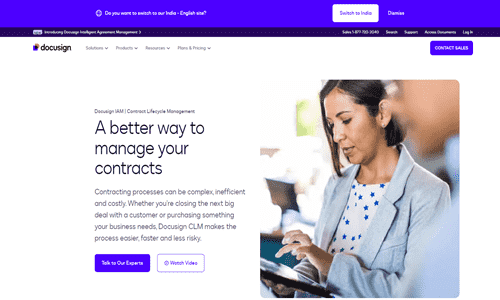
Description:
DocuSign CLM offers comprehensive contract lifecycle management capabilities, including contract generation, collaboration, workflow automation, and integration with DocuSign eSignature.
Pros:
Easy integration with other DocuSign products, robust workflow automation, and strong security features.
Cons:
Higher price points mean a steep learning curve for new users.
Mainly Used For:
Legal, finance, procurement, and sales contract management.
Pricing Package:
Contact for pricing; subscription-based model.
Icertis Contract Management
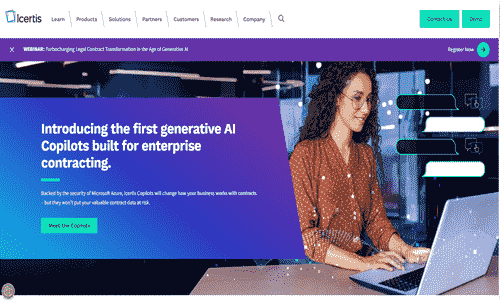
Description:
Icertis provides a flexible and scalable contract management solution with AI-powered analytics and insights for complex contract lifecycles.
Pros:
Highly customizable, strong AI capabilities, and extensive integration options.
Cons:
It can be expensive and requires a significant initial setup.
Mainly Used For:
Enterprise-level contract management across various industries.
Pricing Package:
Contact for pricing; subscription-based model.
Concord
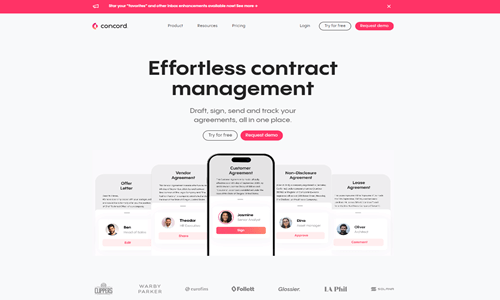
Description:
Concord is a user-friendly contract management platform suitable for small to medium-sized businesses. It streamlines contract creation, negotiation, approval, and storage.
Pros:
Intuitive interface, affordable, unlimited e-signatures.
Cons:
Limited advanced features compared to some competitors; basic reporting capabilities.
Mainly Used For:
Small to medium-sized business contract management.
Pricing Package:
Free tiers are available; paid plans start at $23 per user per month.
ContractWorks
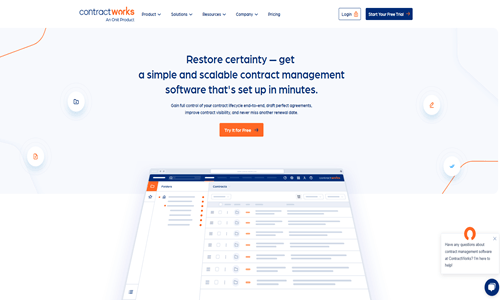
Description:
ContractWorks provides an easy-to-use solution for storing, tracking, and reporting on contracts. Its focus is on simplicity and quick implementation.
Pros:
Quick setup, cost-effective, and strong security features.
Cons:
Limited customization options and fewer advanced features.
Mainly Used For:
Small to medium-sized businesses need quick and straightforward contract management.
Pricing Package:
Starting at $600 per month for up to 10 users.
Agiloft Contract Management Suite
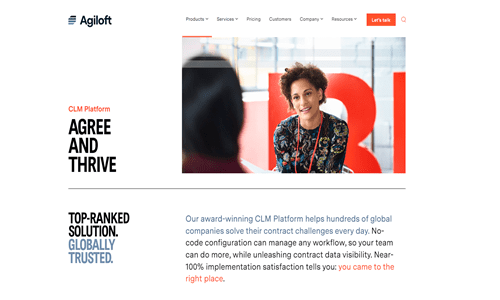
Description:
Agiloft offers a highly customizable contract management suite that covers the entire contract lifecycle with robust automation and integration capabilities.
Pros:
Highly customizable, strong automation features, extensive integrations.
Cons:
Customization can be complex, with a higher learning curve.
Mainly Used For:
Large enterprises and organizations with complex contract management needs.
Pricing Package:
Contact for pricing; subscription-based model.
Vendor Comparison and Reviews of Contract Management
When selecting contract management software, conducting a thorough vendor comparison and reviewing customer feedback can help organizations make informed decisions. Consider the following aspects:
Features and Functionality
- Feature Set: Evaluate each vendor’s features and capabilities, including contract creation, approval workflows, document management, and reporting.
- Customization Options: Examine the software’s adaptability and customization choices to ensure they meet your company’s unique needs.
- Integration Capabilities: Review the vendor’s ability to integrate with other systems, such as CRM, ERP, and document management platforms, to ensure seamless data exchange and workflow automation.
Usability and User Experience
- User Interface: Consider the software’s interface’s intuitiveness and ease of use and the availability of training resources and support materials to facilitate user adoption.
- Mobile Accessibility: Evaluate the availability of mobile apps and functionality for accessing and managing contracts on mobile devices, enhancing users’ flexibility and productivity.
Security and Compliance
- Data Security Measures: To safeguard sensitive contract information, evaluate the vendor’s security procedures, including data encryption, access controls, and adherence to industry laws like the CCPA and GDPR.
- Audit Trail and Compliance Reporting: Review the software’s ability to maintain detailed audit trails and generate compliance reports to support internal audits and regulatory requirements.
Customer Support and Satisfaction
- Customer Reviews: Examine client feedback and reviews to determine customer satisfaction levels and the vendor’s standing for promptness, knowledge, and support.
- Support Services: Assess the responsiveness of customer support channels, their availability, and the level of support given—including continuous maintenance, technical help, and training.
Pricing and Value Proposition
- Pricing Models: Compare the pricing plans and licensing options each vendor offers, considering upfront costs, subscription fees, and scalability.
- Value for Money: Assess the overall value proposition of the software, including the return on investment (ROI) potential, cost savings, and the alignment of features with your organization’s needs and goals.
Frequently Asked Questions
What is the difference between contract management software and document management systems?
This management software is designed to handle the complete contract lifecycle, including creation, negotiation, execution, and performance monitoring. In contrast, document management systems concentrate on storing and organizing various documents.
Can contract management software integrate with existing systems like CRM or ERP?
Yes, most modern contract management software solutions offer integration capabilities with other business systems, such as customer relationship management (CRM), enterprise resource planning (ERP), and document management systems, enabling seamless data exchange and streamlined workflows.
How does contract management software handle version control and audit trails?
Strong contract management software allows users to examine revisions’ history and audit trail by tracking contract changes using version control tools. This guarantees accountability and openness across the whole contract lifespan.
Can contract management software automate approval workflows and notifications?
Contract management software typically includes workflow automation capabilities, allowing organizations to define custom approval processes, assign tasks and responsibilities, and automatically send notifications and reminders based on predefined rules or events.
How does contract management software support collaboration and negotiation?
Many contract management solutions offer collaboration features, such as redlining, commenting, and simultaneous editing, facilitating seamless negotiation and collaboration among multiple parties involved in the contract process.
What security measures are typically included in contract management software?
Data security is a top priority for contract management software suppliers, who usually include features like encryption, user authentication, access controls, audit trails, and compliance with industry standards like SOX, CCPA, and GDPR.
Conclusion
In conclusion, effective contract management is the cornerstone of any successful business relationship. Investing in clear agreements, streamlined processes, and consistent communication ensures your contracts work for you, not against you. This proactive approach minimizes risk, fosters stronger partnerships, and paves the way for a more secure and prosperous future.




